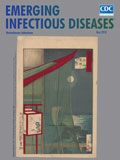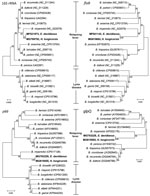
Volume 24, Number 5—May 2018
Research Letter
Borrelia miyamotoi sensu lato in Père David Deer and Haemaphysalis longicornis Ticks
On This Page
Article Metrics
Altmetric:
Citations: 0
Views: 107Views equals page views plus PDF downloads
Metric DetailsAbstract
By sequence analysis of 16S rRNA, flaB, p66, and glpQ, we identified Borrelia miyamotoi in 1 of 4 Père David deer (n = 43) seropositive for Borreliaspp. and 1.2% (3/244) of Haemaphysalis longicornis ticks from Dafeng Elk National Natural Reserve, China. Future studies should assess Borreliapathogenesis in deer.
Père David deer (Elaphurus davidianus) are extinct in the wild and found only in captivity, principally in China, England, and the United States. Just 5,000 animals remain, with 40% located in Dafeng Elk National Natural Reserve in China, which attracts >1 million tourists annually. Ticks are common in the Dafeng Elk National Natural Reserve (1), so we investigated the tickborne bacterial pathogens in Père David deer at this reserve.
The institutional animal care and use committee of Yangzhou University College of Veterinary Medicine (Yangzhou, China) (YZU-CVM#2015–076) approved this study. We took whole blood samples from 43 apparently healthy Père David deer (20 males, 23 females), separated out the plasma (1,800 × g for 10 min), and used the plasma to detect antibodies against bacterial pathogens with the SNAP 4Dx kit (IDEXX, Westbrook, ME, USA) (2) according to the manufacturer’s instructions. Further, ELISAs and Western blots using Borrelia miyamotoi GlpQ recombinant protein (RayBiotech, Norcross, GA, USA) and peroxidase-labeled rabbit anti-deer IgG (SeraCare, Milford, MA, USA) were performed as described previously (3) to detect GlpQ antibodies specific to B. miyamotoi.
We collected a convenience sample of Haemaphysalis longicornis ticks (n = 244) from elk in the Dafeng Elk National Natural Reserve during the summer of 2016 and stored the collection at −80°C. We used the High Pure PCR Template Preparation Kit (Roche Diagnostics GmbH, Mannheim, Germany) according to the manufacturer’s instructions to extract DNA from Père David deer whole blood samples and entire H. longicornis ticks. We used published PCR protocols targeting the 16S rRNA (4), flaB (5), and glpQ (6) genes and an in-house p66 PCR (forward primer 5′-CGATTTTTCTATATTTGGACACAT-3′, reverse primer 5′-GATATAGATTCTACAGGTATTGCATAATC-3′) to screen blood samples and ticks for B. miyamotoi. We sequenced both strands of PCR products using BGI’s (Shanghai, China) services and aligned them using ClustalW in MEGA 7 (http://www.megasoftware.net/) with the nucleotide sequences of 11 relapsing fever group borreliae and 7 Lyme disease group borreliae found in GenBank.
Four (9.3%; 1 male, 3 females) of the 43 deer were seropositive by SNAP 4Dx, demonstrating an immunodominance of antibodies against synthetic C6 peptide invariable region 6 of the pathogenic Borrelia genospecies, B. burgdorferi sensu stricto, B. garinii, and B. afzelii (7). Seropositivity was confirmed by GlpQ antibody ELISA and Western blot with GlpQ recombinant protein, indicating exposure to B. miyamotoi.

Figure. Neighbor-joining phylogenetic trees constructed with 16S rRNA, flaB, p66, and glpQ gene sequences of Borrelia spp. isolates collected from Père David deer (Elaphurus davidianus) and Haemaphysalis longicornis ticks, Dafeng Elk National...
One of the seropositive female deer (2.3% of overall deer population) and 3 (1.2%) of the 244 ticks were positive for the 4 Borrelia genes tested (16S rRNA, flaB, glpQ, p66) by PCR. The sequences obtained from the PCR products showed the 4 animals had identical sets of Borrelia genes. The 16S rRNA, flaB, and p66 sequences were more similar to those of the relapsing fever group borreliae (16S rRNA 97.9%–99.3%, flaB 83.7%–88.9%, p66 72.4%–83.3%) than the Lyme disease group borreliae (16S rRNA 96.6%–97.2%, flaB 79.2%–80.9%, p66 66.1%–68.1%). The B. miyamotoi glpQ gene sequence obtained from the deer and ticks also clustered with those of the relapsing fever group borreliae (81.1%–88.9%), and all analyzed gene sequences had greatest similarity with B. miyamotoi genes (16S rRNA 99.3% [576/580], flaB 88.9% [321/361], p66 83.3% [423/508], glpQ 88.9% [377/424]) (Figure).
B. miyamotoi is a member of the relapsing fever group first isolated in Japan and subsequently found in North America, Europe, and Russia (8). B. miyamotoi has not been reported in deer but can be pathogenic in humans, usually resulting in an acute febrile influenza-like illness but occasionally causing severe disease, including meningoencephalitis (9). Further studies are needed to determine the effects of B. miyamotoi infections in deer, especially because studies on Ixodes scapularis ticks in the United States have indicated that deer might be a sylvatic reservoir (10).
I. persulcatus and I. pavlovskyi ticks are known to be infected with B. miyamotoi in Asia, whereas other Ixodes spp. ticks are vectors in the United States and Europe (9). Tick control in semi–free-ranging animals is challenging; the Père David deer we studied are commonly infested with ticks. The only tick species identified on Père David deer in Dafeng Elk National Natural Reserve was H. longicornis (1), which can reach high densities in the environment (summer 89.5 ± 17.1 ticks/10 m2, winter 1.47 ± 0.35 ticks/10 m2) and cause anemia and even death in heavily infested animals. Our finding of B. miyamotoiin H. longicornis ticks adds to the list of organisms reported in this tick, primarily B. burgdorferi sensu lato and unclassified Borrelia spp.
In summary, we have shown that B. miyamotoi sensu lato occurs in Père David deer and H. longicornis ticks in Dafeng Elk National Natural Reserve. Further studies are needed on the pathogenicity of the organism in deer and the role of H. longicornis ticks in the epidemiology of infections in deer and humans.
Dr. Yang is a doctoral student at the Yangzhou University College of Veterinary Medicine in Yangzhou, China. His primary research interests are veterinary pathogens with zoonotic potential.
Acknowledgment
This project was supported by the National High Technology Research and Development Program of China (2013AA102505-5), National Natural Science Foundation of China (31472067), Scientific Innovation Research of College Graduate Program in Jiangsu Province (KYZZ16_0496), the Excellent Doctoral Dissertation Scholarship of Yangzhou University, and the Priority Academic Program Development of Jiangsu Higher Education Institutions.
References
- Shen H, Ding YH, Xu AH, Ren YJ, Hou LB, Yuan GX. Haemaphysalis longicornis in captive and free-ranging Père David’s deer (Elaphurus davidianus). Chin J Vet Parasitol. 2007;15:60–1.
- Chandrashekar R, Daniluk D, Moffitt S, Lorentzen L, Williams J. Serologic diagnosis of equine borreliosis: evaluation of an in-clinic enzyme-linked immunosorbent assay (SNAP® 4Dx®). Int J Appl Res Vet Med. 2008;6:145–50.
- Krause PJ, Narasimhan S, Wormser GP, Barbour AG, Platonov AE, Brancato J, et al.; Tick Borne Diseases Group. Borrelia miyamotoi sensu lato seroreactivity and seroprevalence in the northeastern United States. Emerg Infect Dis. 2014;20:1183–90. DOIPubMed
- Zhai B, Niu Q, Yang J, Liu Z, Liu J, Yin H, et al. Identification and molecular survey of Borrelia burgdorferi sensu lato in sika deer (Cervus nippon) from Jilin Province, north-eastern China. Acta Trop. 2017;166:54–7. DOIPubMed
- Clark KL, Leydet B, Hartman S. Lyme borreliosis in human patients in Florida and Georgia, USA. Int J Med Sci. 2013;10:915–31. DOIPubMed
- Fomenko NV, Livanova NN, Borgoiakov VI, Kozlova IV, Shulaĭkina IV, Pukhovskaia NM, et al. [Detection of Borrelia miyamotoi in ticks Ixodes persulcatus from Russia]. Parazitologiia. 2010;44:201–11.PubMed
- Liang FT, Aberer E, Cinco M, Gern L, Hu CM, Lobet YN, et al. Antigenic conservation of an immunodominant invariable region of the VlsE lipoprotein among European pathogenic genospecies of Borrelia burgdorferi SL. J Infect Dis. 2000;182:1455–62. DOIPubMed
- Fonville M, Friesema IH, Hengeveld PD, Docters van Leeuwen A, Jahfari S, Harms MG, et al. Human exposure to tickborne relapsing fever spirochete Borrelia miyamotoi, the Netherlands.Emerg Infect Dis. 2014;20:1244–5. DOIPubMed
- Krause PJ, Fish D, Narasimhan S, Barbour AG. Borrelia miyamotoi infection in nature and in humans. Clin Microbiol Infect. 2015;21:631–9. DOIPubMed
- Han S, Hickling GJ, Tsao JI. High prevalence of Borrelia miyamotoi among adult blacklegged ticks from white-tailed deer. Emerg Infect Dis. 2016;22:316–8. DOIPubMed
Figure
Cite This ArticleOriginal Publication Date: 3/26/2018
1These senior authors contributed equally to this article.






















.png)











No hay comentarios:
Publicar un comentario